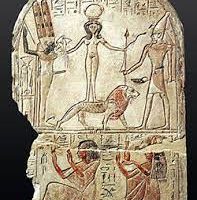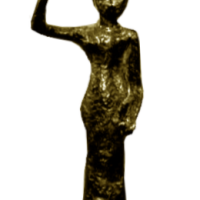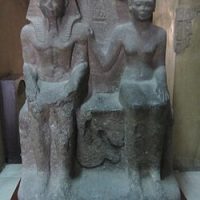Anat : The Warrior Goddess
Listen
At a glance
| Description | |
|---|---|
| Origin | Middle Eastern Mythology |
| Classification | Gods |
| Family Members | El (Father), Athirat (Mother), Baal (Brother) |
| Region | Syria, Lebanon, Israel, Jordan, Egypt |
| Associated With | War, Violence |
Anat
Introduction
Anat, also spelled Anath, is one of the most powerful and complex deities of the Ugaritic and Canaanite pantheons. Emerging from the Late Bronze Age texts discovered at Ugarit (modern Ras Shamra in Syria), she is celebrated as a goddess of war, hunting, and vengeance, while also displaying protective and nurturing aspects. Anat’s fierce independence and violent tendencies distinguish her from the more fertility-centered goddesses of the ancient Near East. In myths such as the Baal Cycle and the Epic of Aqhat, she appears as both destroyer and protector, a duality that reflects the precarious balance of life and death in agrarian societies. Her worship extended beyond Canaan into Egypt, where she was integrated into the royal and military cults. The stories of Anat demonstrate not only her dominance in battle but also her role in maintaining cosmic order alongside her divine counterparts.
Physical Traits
Anat’s physical representations highlight her martial identity and divine authority. Ugaritic texts often call her “btlt” or “the maiden,” not as a marker of virginity but as an indication of her untamed and autonomous character. Iconographically, Anat is shown as a youthful goddess, armed with weapons such as spears, shields, and axes. Egyptian art sometimes portrays her nude or riding horseback, a symbol of both her sexual allure and her violent power. Statues and reliefs depict her adorned with the Atef crown or a tall headdress, linking her to kingship and divine authority. A basalt stela from Beth-shan shows Anat in a form similar to Astarte, holding symbols of life such as the ankh while still carrying a staff of power, emphasizing her dual role as life-giver and destroyer. Her physique is described as slender, youthful, and vigorous, aligning with her image as a warrior who thrives in battle yet remains eternally vital.
Family
In Ugaritic mythology, Anat is often described as a daughter of El, the high god, and Athirat (also known as Asherah), the great mother of the gods. Her close relationship with Baal, the storm and fertility god, is central to many myths. She is sometimes portrayed as his sister, in other instances as his consort, reflecting the fluidity of mythological kinship structures. Her loyalty to Baal is unwavering; when Baal is threatened or slain by rivals such as Mot, the god of death, or Yam, the sea deity, Anat takes violent vengeance on his behalf. This role underscores her importance as both ally and avenger, ensuring the balance of divine power. In some traditions, Anat also works alongside Asherah in negotiating with El to support Baal’s rise, demonstrating her political and persuasive power within the pantheon. While her appearances in biblical texts are limited, usually in place names, her familial role in Ugaritic myth positions her as one of the most active and influential daughters of El.
Other Names
Anat’s identity was expressed through a variety of names and epithets across cultures. In Ugaritic texts, she appears as 𐎓𐎐𐎚 (ʿnt), while in Hebrew inscriptions she is known as עֲנָת (ʿĂnāṯ). Phoenician texts preserve her as 𐤏𐤍𐤕 (ʿNT), and in Egypt she was recorded as ꜥntjt. Akkadian inscriptions also reference her under the names Ḫanat or Kanat. She is frequently described with titles such as “Virgin Anat,” “Progenitress of Heroes,” and “Kindred of the Peoples,” each emphasizing different aspects of her divine power. The epithet “Maiden Anat” is particularly prominent, highlighting her autonomy rather than marital status. In Egypt, she was honored with titles such as “Herit-Anta,” meaning “Terror of Anat,” reflecting her fearsome reputation as a goddess of war. These variations not only reveal the widespread worship of Anat but also her adaptability across different linguistic and cultural contexts.
Powers and Abilities
Anat’s powers are vividly portrayed in myth, where she dominates as a goddess of war, vengeance, and protection. In the Baal Cycle, she slaughters armies with unmatched ferocity, reveling in rivers of blood and standing knee-deep in the corpses of her enemies. Her violent strength is not senseless but purposeful, often used to defend Baal or avenge his death against rival gods like Mot. This martial power made her the divine embodiment of protection for her followers, particularly in times of conflict.
Beyond her battlefield dominance, Anat also held influence over fertility and renewal, although not in the same way as Asherah or Astarte. Her mourning for Baal and her ritual lamentations were believed to restore cosmic balance and ensure agricultural cycles continued. In the Epic of Aqhat, Anat’s desire for a sacred bow crafted by the god Kothar-wa-Hasis reveals her ambition and vengeance; when denied, she orchestrates Aqhat’s death, unleashing a drought that devastates the land. This story underscores both her destructive wrath and her role in controlling the fertility of the earth.
Anat is also portrayed as a “mistress of animals,” a figure who both hunts and protects, emphasizing her control over the natural and human worlds. Her capacity to confront death directly, as seen in her battle with Mot, further demonstrates her unparalleled power. She was not simply a goddess of destruction but a divine force who could bend death, fertility, and war to her will.
Modern Day Influences
While Anat’s direct cult faded with the rise of monotheistic religions, her legacy survives in both cultural memory and modern scholarship. In Egypt, her worship endured into the New Kingdom, where she was especially revered by soldiers and even honored by Pharaoh Ramesses II, who named one of his daughters Bint-Anat (“Daughter of Anat”). This integration into Egyptian religion highlights her enduring appeal as a goddess of war and protection.
In Israel and Jewish communities worldwide, Anat persists as a personal name, symbolizing heritage and continuity. Academic interest in Anat remains strong, as scholars examine her role in shaping the archetype of the warrior goddess. Comparative mythology has linked her to deities such as Athena in Greek culture, Sekhmet in Egyptian tradition, and Inanna in Mesopotamian myth, suggesting her archetype influenced broader Mediterranean and Near Eastern religious thought.
Feminist interpretations of Anat’s mythology focus on her independence and ferocity, presenting her as a counterbalance to traditionally maternal or nurturing goddess figures. Her blood-soaked victories, vengeance against injustice, and unwavering autonomy make her a symbol of female strength and agency in mythological studies.
In popular culture, Anat occasionally appears in literature, fantasy fiction, and gaming as a warrior goddess or avenger, reflecting her enduring image as a divine figure of strength and determination. Archaeological discoveries, including inscriptions, stelae, and temple remains, continue to reveal new insights into her worship, ensuring that Anat remains a subject of fascination for both scholars and enthusiasts of ancient mythology.
Related Images
Source
Smith, M.S. (2001). The Origins of Biblical Monotheism: Israel’s Polytheistic Background and the Ugaritic Texts. Oxford University Press.
Day, J. (2002). Yahweh and the Gods and Goddesses of Canaan. Sheffield Academic Press.
Wyatt, N. (2007). Religious Texts from Ugarit: The Words of Ilimilku and His Colleagues. Sheffield Phoenix Press.
Coogan, M.D. (1978). “Canaanite Origins and Lineage: Reflections on the Religion of Ancient Israel.” Pages 115–131 in Ancient Israelite Religion: Essays in Honor of Frank Moore Cross. Fortress Press.
Wiggins, S.A. (1996). A Reassessment of Asherah: With Further Considerations of the Goddess. Ugarit-Verlag.
Korpel, M.C.A. (2004). “Asherah: A Female God in Israel and Judah.” Biblical Archaeology Review, 30(6), 20-31.
Greenstein, E.L. (1993). “The Goddess Anat in Ugaritic Myth.” In S. Parpola & R.M. Whiting (Eds.), Sex and Gender in the Ancient Near East (pp. 97-111). Neo-Assyrian Text Corpus Project.
Ugarit and Canaanitic Mythology. (2025). Retrieved from https://www.worldhistory.org/Anat/
Moses, H. (2025, September 25). Anat and Baal: The Palace Myth of War and Renewal in Canaan. History and Myths. https://www.historyandmyths.com/2024/12/anat-baal-canaanite-mythology.html
Wikipedia contributors. (2025). Anat. Wikipedia. https://en.wikipedia.org/wiki/Anat
World History Edu. (2024). The Goddess Anat in Ancient Times. https://worldhistoryedu.com/the-goddess-anat-in-ancient-times/
Smith, M. S. (2001). The Origins of Biblical Monotheism: Israel’s Polytheistic Background and the Ugaritic Texts. Oxford University Press.
Pardee, D. (2002). Ritual and Cult at Ugarit. Society of Biblical Literature.
Keel, O., & Uehlinger, C. (1998). Gods, Goddesses, and Images of God in Ancient Israel. Fortress Press.
Frequently Asked Questions
What is lorem Ipsum?
I am text block. Click edit button to change this text. Lorem ipsum dolor sit amet, consectetur adipiscing elit. Ut elit tellus, luctus nec ullamcorper mattis, pulvinar dapibus leo.
What is lorem Ipsum?
I am text block. Click edit button to change this text. Lorem ipsum dolor sit amet, consectetur adipiscing elit. Ut elit tellus, luctus nec ullamcorper mattis, pulvinar dapibus leo.
What is lorem Ipsum?
I am text block. Click edit button to change this text. Lorem ipsum dolor sit amet, consectetur adipiscing elit. Ut elit tellus, luctus nec ullamcorper mattis, pulvinar dapibus leo.
What is lorem Ipsum?
I am text block. Click edit button to change this text. Lorem ipsum dolor sit amet, consectetur adipiscing elit. Ut elit tellus, luctus nec ullamcorper mattis, pulvinar dapibus leo.
What is lorem Ipsum?
I am text block. Click edit button to change this text. Lorem ipsum dolor sit amet, consectetur adipiscing elit. Ut elit tellus, luctus nec ullamcorper mattis, pulvinar dapibus leo.









